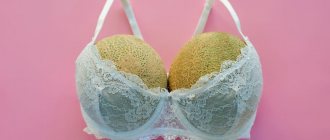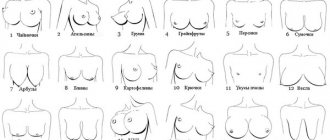Not only the beauty of her breasts, but also her ability to feed a newborn baby will depend on the natural anatomy of a woman’s nipples. Each representative of the fairer sex has a breast that has its own special attractiveness; there are differences not only in size, but also in relation to the shape and color of the nipples. Such differences are normal and should not bother a woman, since such breast characteristics depend on genetics, race, and some other indicators.
Nipple structure
If we consider the structure of the nipple, it is formed in the form of a protrusion above the mammary gland. It is an accumulation of skin, and it is especially delicate and sensitive due to the accumulation of receptors, as well as close contact with nerve endings, including the intercostal system.
The anatomy of the nipples suggests a relationship with halos, which may have a darker shade. On the surface of the areola there are small tubercles, which are sources of secretion of special compounds that prevent drying out and damage to the nipples. Their functions are especially important during breastfeeding.
Change continues
We looked at how nipples change during pregnancy. All that remains to be added is that the increase in pain will continue until the third trimester. You may now notice clear fluid leaking from your nipples. This suggests that the body is serious about the birth of the baby and breastfeeding. There is no need to specifically squeeze it out, as this can provoke uterine contractions and lead to premature birth.
Another change is the appearance of small pimples near the nipples. This may worry the young woman, but, in fact, nothing terrible is happening. Painful nipples become enlarged, and the glands, which were hidden until now, now peek out. Very little time will pass and they will disappear again without a trace.
Nipple color and what it depends on
The skin tone of the nipples and adjacent areola can be different, since each organism has its own certain amount of hormones responsible for skin color and pigmentation. That is why the color of the nipples can change over time, for example, in girls they are often light pink, during puberty they darken a little, and during pregnancy the shade can change in any direction, although darkening of the tissue is more often observed.
The fundamental factor in the color of the outer part of the mammary gland is race, genetic predisposition, and hormonal background.
Natural cycle
If the nipples darken just before the start of menstruation, this is due to hormonal changes. It's not dangerous at all. With the onset of menstruation, the nipples will become less sensitive and return to their normal state. These are not the only symptoms. At this time, the breasts usually increase in size and become painful. However, all this is very individual. Someone complains that walking without a bra becomes uncomfortable even at night. Others, on the contrary, do not feel any changes. PMS symptoms are very individual, for some they are a real torment, but for others they are a completely invisible phenomenon.
The shape of the nipples and what it depends on
The normal anatomy of the nipples suggests differences in the shape and size of the protrusions themselves, and this should not bother a woman, since each woman’s breasts have individual characteristics. If we classify nipples by shape, we can distinguish the following types:
1. Convex or protruding. They protrude significantly above the breasts; some women experience discomfort, since the nipples stand out especially under clothing; 2. Normal. The conditional norm is considered to be an average elevation above the surrounding tissues; a natural increase occurs with changes in temperature and emotional arousal; 3. Flat. According to some reports, flat nipples are more common in women. They are almost at the same level with the areola, but under certain influences that affect sensitivity, they rise slightly 4. Retracted. If retraction develops from birth, then during puberty or after childbirth a change in shape is possible, since the anatomy of the nipples suggests some age-related changes. During the breastfeeding period, a specialist may be required to establish lactation and help the baby adapt to the mother’s breast. In case of sudden changes in the breast, you should contact mammology for diagnostic measures. 5. Versatile. Nature allows some asymmetry and it may affect the nipples. This is not considered an abnormality, but sometimes requires observation, especially if there are strong differences, for example, one nipple is inverted and the other is protruding.
In addition to the shaped difference, there are several options for the direction of the nipples. They can be straight, have opposite lines, or point down, which is more common in women over 40 years old. These indicators vary for every woman, especially for those who have given birth and nursed their babies for a long time. For the anatomy of the nipples, changing direction is natural, but there are some techniques that help support the skin, for example, proper attachment of the baby when feeding, care, massage, special underwear, and so on. The shapes and sizes of the outer part of the breast may differ from generally accepted standards presented in the modeling business and other fields. Only this fact should not become the reason for surgical intervention, since the specialist can also propose other programs to change the size and shape of the nipples, if this is really necessary.
What to do to alleviate the condition?
Experts recommend reducing salt intake a week before the start of your period. This will help relieve PMS symptoms. When the next peak approaches, avoid lace underwear with underwires. It's better to take a sports bra. For severe pain, you can take aspirin or ibuprofen. Doctors recommend diuretics - parsley or celery, green tea. If improvement does not occur in the next few days, then you should not wait any longer, consult a doctor and get examined.
Functions of the nipple
More often, breasts are one of the attractive parts of a woman’s body, but, nevertheless, its main function, inherent in nature, is feeding offspring. Milk flows through the nipples, passing through the ducts and previously formed and accumulated in the alveoli.
The anatomy of the nipple means that this part of the breast is highly sensitive. It has many receptors, nerve endings and the finest tissues. If we consider the additional functions of the outer part of the chest, its features, we can highlight:
• Additional sexual stimulation, and touching can bring pleasure to both partners; • Changes in shape can signal temperature changes in the body. When there is cold or chills, the nipples harden and change shape; • The hormonal state of a woman is reflected in the configuration and color of the nipple, and this can become a signal for additional examination; • An attribute of attractiveness, which for some is one of the most important in a woman’s appearance.
The characteristics of the breast largely depend on physiological, age and genetic characteristics, so each lady finds her own functions for her.
Different periods of the month
The second phase of the cycle is usually marked by breast tenderness and swelling. The reason lies in the increased concentration of progesterone, which leads to such symptoms. Similar processes occur in the epithelial layer of the uterus. If your nipples have darkened, this may be an individual reaction to hormonal changes. Usually within a few days their condition will return to normal. Maximum discomfort occurs on the 7th day of the second phase of the cycle.
The second point that women note is ovulation. At this time, estrogen is released, which also leads to a number of necessary changes. In particular, the egg matures and exits into the fallopian tubes, where it can meet the sperm. Usually the breast reaction to ovulation is not noticeable, but some women claim that their nipples have darkened. This can also be attributed to individual changes in the body.
The third stage, as a rule, occurs in the very middle of the cycle. It is characterized by a decrease in estrogen levels. Small nipples most often enlarge during this period. At the same time, the tension in the chest increases. These are completely physiological symptoms that do not indicate the presence of any pathology. If tension in the chest, enlargement and darkening of the nipples are observed regularly, at approximately the same time, then this is considered a normal reaction of your body.
General data and interesting information
In their desire to acquire ideal, by generally accepted standards, breasts, some women make irreparable mistakes. To avoid such troubles, you should have a superficial understanding of the anatomy of the nipples and adhere to the following recommendations:
1. Correctly selected underwear is a good prevention of sagging breasts and changes in the direction of the nipples; 2. Surgical correction of the soft tissues of the glands involves changing the protruding parts, otherwise proportionality is lost, for example, a large breast and a small nipple; 3. Small nipples are not an obstacle or serious difficulty in breastfeeding, nor are inverted or large nipples. The situation can be corrected by attachments and specialist consultations; 4. It is necessary to select appropriate cosmetics specifically for nipples and not only during lactation. This will help prevent dryness and cracks, which will only have a positive effect on the condition of the skin; 5. There are temporary changes in the nipples that occur due to hormones. This may be the appearance of hair, tubercles, darkening, or increase in size. There is no need to be afraid of such phenomena, they are often caused by natural restructuring of the body, but contacting a mammologist will be useful.
Every woman should not only worry about the attractiveness of her breasts, including the shape, color, and size of the nipples, but also take care of the health of the mammary glands. This also applies to a meaningful attitude towards surgical interventions, the feasibility of which should always be discussed with a specialist.
Changes during pregnancy
Quite often, you can determine your new interesting position not by a delay in menstruation, but by a change in breast sensitivity. Here, too, everything proceeds differently for each woman. Some say that long before the delay they felt that their breasts began to enlarge. Other patients attribute this to yesterday's cakes and weight gain, but in any case, such drastic changes should be alarming. Often, experienced women have an alarming thought: “My nipples have darkened, are I really pregnant?” In order to find the exact answer to this question, you can take a test at the pharmacy or go for a consultation with a gynecologist.
But this is only the first news. Very soon the woman notices that the nipples have darkened. Once tender and pink, they not only change color, but also become rough. Moreover, it is easier to determine this by sight, but it is very difficult to touch them during this period. Sensitivity increases so much that it can even turn into pain. Let's look at what happens to a woman's nipples, what anatomical changes lead to such consequences.
Formula for ideal female breasts
Scientists from Italy have discovered the formula for the ideal female bust. To do this, you need to imagine triangle ABC, as shown in the picture. Segment AC - we will consider the base of the triangle, the corners on the nipples and in the cavity of the collarbone.
The length AC must be divided by 2, then the resulting number is divided by the length of the segment AB and we find out the number of breast parameters. The correct and most beautiful breast shape corresponds to a number from 0.4 to 0.6.
Ideal breast parameter distance:
- between the nipples there should be from 20 cm to 21 cm,
- from navel to nipple, from 24 cm to 25 cm,
- the diameter of the base of the chest is from 12 to 13 cm.
Systemic hormonal diseases
Our body reacts to any changes in the secretion produced by the endocrine glands. And the body will respond to any violations with changes in the breast tissue. Therefore, if the nipples are enlarged and darkened, this may be a symptom of pathology. If you suspect this, you should definitely visit a mammologist. It is especially important to seek help if there are other symptoms, such as changes in breast shape, nipple retraction or redness.
How to choose the right underwear
When the question arises about choosing a bra, you must follow the following recommendations:
- the bra should always be the right size,
- a bra with thick foam cups is more suitable for those with modest shapes,
- a bra in the shape of the letter “T” is better to buy for girls and women with a large bust size and a fallen shape,
- a bra with a horizontal seam visually makes the bust more rounded.
Choosing underwear depending on breast shape
Different shapes of female breasts also mean wearing different underwear:
- "Circe" or classical form. Girls with such an ideal breast shape are suitable for any bra model. When choosing underwear, you can only focus on personal preferences.
- "Globe". It is recommended to wear a bra with a jumper, which will be completely adjacent to the breast bone or will have no breast bone at all. In order to raise the bust, it is better to choose a bodice with underwires that reach the middle of the chest; the seams in the cups of the bodice should be stitched. A good choice would be the Plange bra.
- "Renaissance". Special attention requires only the correct choice of size.
- "Chestnut". Wireless bras with contoured cups, or bodices with a cup sewn from three parts, as well as bodices with a central seam in the lower half are suitable.
- "Water surface". The cups of the bodice should be full-sized and have inserts on the sides in order to freely place the breasts in them and direct them forward.
- "Alma mater". Models with underwires that smoothly fit the chest and inserts made of dense fabric to compensate for volume are suitable. Minimizing bras are ideal.
- "Buds." Bras with contoured cups and extra pads are great for this breast type. Push-up bodices and bandeau bras will be the best choice.
- "Sappho". A push-up bodice with bottom and side inserts is best suited to give volume to the bust.
- "Chloe." To add volume, bodices with underwires and soft contoured cups are suitable.
What should you not do?
Often women put off visiting a doctor. And since unpleasant and painful sensations persist, they use available means to eliminate them. These could be painkillers or antibiotics. Medicinal herbs, tinctures and lotions are often used. In fact, it is impossible to cure an unknown pathology using such methods. Therefore, take the time to visit the clinic.
If you are firmly convinced that the cause is not ovulation or pregnancy, then you must additionally undergo an ultrasound or mammogram. Important information is provided by a blood test for hormone levels. After the examination, the doctor will make a decision and prescribe treatment.
Inflammatory diseases
This is a fairly large group of pathologies, which is primarily characterized by redness and fever, darkening and engorgement of the nipples. Discharge often appears. Be sure to carefully examine and tell your doctor about the nature of these discharges. If there is blood in them, then we should talk about pathology of the mammary gland ducts. It could be intraductal papilloma or something even more serious. Pay attention to the appearance of the nipples. If they have lost their shape and seem to be drawn inward, this may indicate the development of oncology. In any case, if you consult a doctor, it won’t get any worse.









